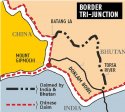That is assuming Gipmochi is the same as Gyomochen which is the Indian interpretation But the map is the mapAnyway Xinhua mock Indian transgression
And for years the Indian never dispute the Chinese possession of the disputed area How come now suddenly they come up with this excuse Another excuses from India like so many before that doesn't hold water. September is coming and if nothing is resolved it will be crunched time. Because by then the Bric conference is over and China wrap up their National congress
Another thing even if it is true it is matter between Bhutan and China how come Indian insert itself into the dispute ? It doesn't make sense contrary to international law and custom
The other principle is LOC. Disputed it maybe but it is within China LOC and as such it is defacto border pending final resolution
Separately, a Xinhua video in English, entitled “The Seven Sins of India”, accuses India of “trampling international law” and “confusing right and wrong” over the Doklam crisis.
Chinese media campaign on the Doklam crisis has become sharper, shriller, and a shade bizarre, with a daily newspaper on Thursday threatening that Chinese authorities may soon issue an “ultimatum” to India to end the Himalayan standoff.
Simultaneously, state-run
Xinhua news agency released a video mocking India for ''deliberately disregarding the enormity of the mounting crisis.''
Both items allude to the urgency in defusing the crisis and avoiding a war through India’s unilateral withdrawal from the Doklam plateau.
A write-up in the state-run
Global Times, which analysts say does not necessarily reflect the governmental view, asserts that China is likely to issue an “ultimatum” before September calling for the total withdrawal of Indian troops .
It quoted Xu Guangyu, a retired Rear Admiral and senior adviser to the China Arms Control and Disarmament Association, as saying that “if India keeps its troops in Chinese territory, China's foreign and defence ministries are very likely to release an ultimatum before September".
China maintains that India has infringed on its “sovereignty” in Doklam by sending its troops to stop Chinese road construction in the area. China’s position is rejected by Bhutan, which has publicly stated that the Doklam plateau is a disputed territory between the two countries.
Admiral Xu says, “The ultimatum will clearly tell India and the world that China will give a certain number of days to India to withdraw its troops. After the deadline, if Indian troops still remain within China's territory, India will be responsible for all the consequences. China has multiple ways of pushing India back to its own soil if India ignores the ultimatum, as a few dozen military personnel and one bulldozer [in Doklam] is a piece of cake for the Chinese military.”
But Admiral Xu acknowledges that “Indian troops will resist, and if there is bloodshed, China needs to be fully prepared for military conflict”.
The daily then highlights China’s combat superiority on account of its world class rocket artillery, as well as air power, relying on fighter jets, bombers and helicopters operating from “at least five large airports in Tibet”.
It also highlighted that arrangements are being made to have sufficient stocks of blood drawn from several provinces. It added that blood stocks from the recent earthquake hit area of Sichuan province were likely being transferred to Tibet.
Separately, a
Xinhua video in English, entitled “
The Seven Sins of India”, targeting a young foreign audience, accuses India of “trampling international law” and “confusing right and wrong” over the Doklam crisis. The presenter accuses Indian authorities of being “so thick skinned” for failing to acknowledge that they are “trampling international law” by entering “undisputed” Chinese territory.
“When the whole world is trying to wake India up from its impulse, China has realised it’s impossible to wake up a guy who is pretending to be asleep,” says the presenter. The camera than shifts to an actor, with a beard and Sikh turban. Amid canned laughter, he waggles his head and speaks English in a pronounced Indian accent.
With focus on Doklam shifting to the options of using force, an article in the state-run
China Daily asks the question: “So should China use force if India continues to refuse to withdraw its troops? If yes, on what scale? And what price is it prepared to pay?”
Written by Zhou Bo, a senior Colonel in the People’s Liberation Army, the article observes that, “Excellence of weaponry is no longer a big issue for the PLA.”
It adds, “ Thanks to decades of strenuous efforts and supported by the robust Chinese economy, the Chinese defence industry has broken the technological bottleneck and the arms embargo of the West to produce some of the most advanced weapons in the world.” The writer views the Doklam crisis as a “litmus test” for the PLA.
Observers point out that amid the “saturation fire” from the state media, there is a common thread shared with the officialdom of seeking India’s unilateral withdrawal from Doklam—a position from where China, will find it hard to backtrack.




